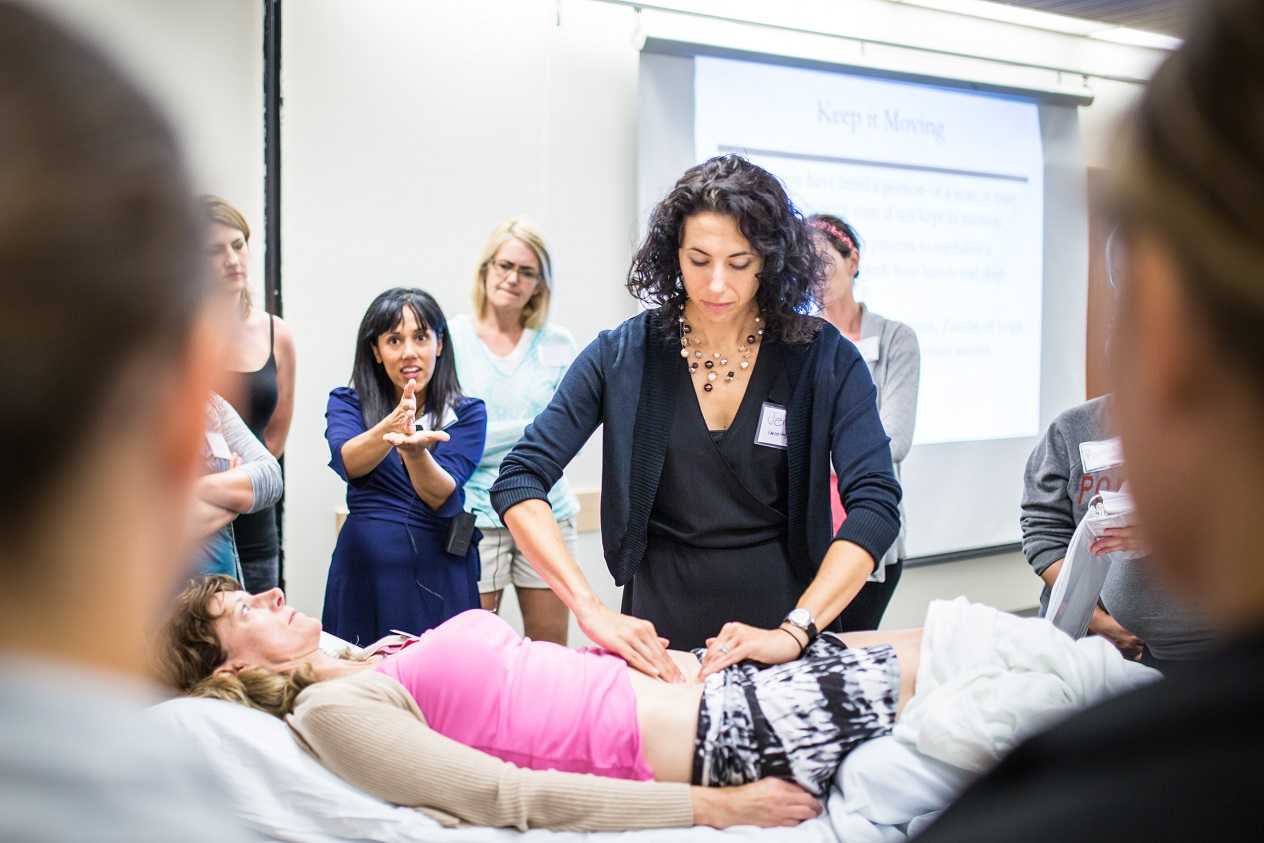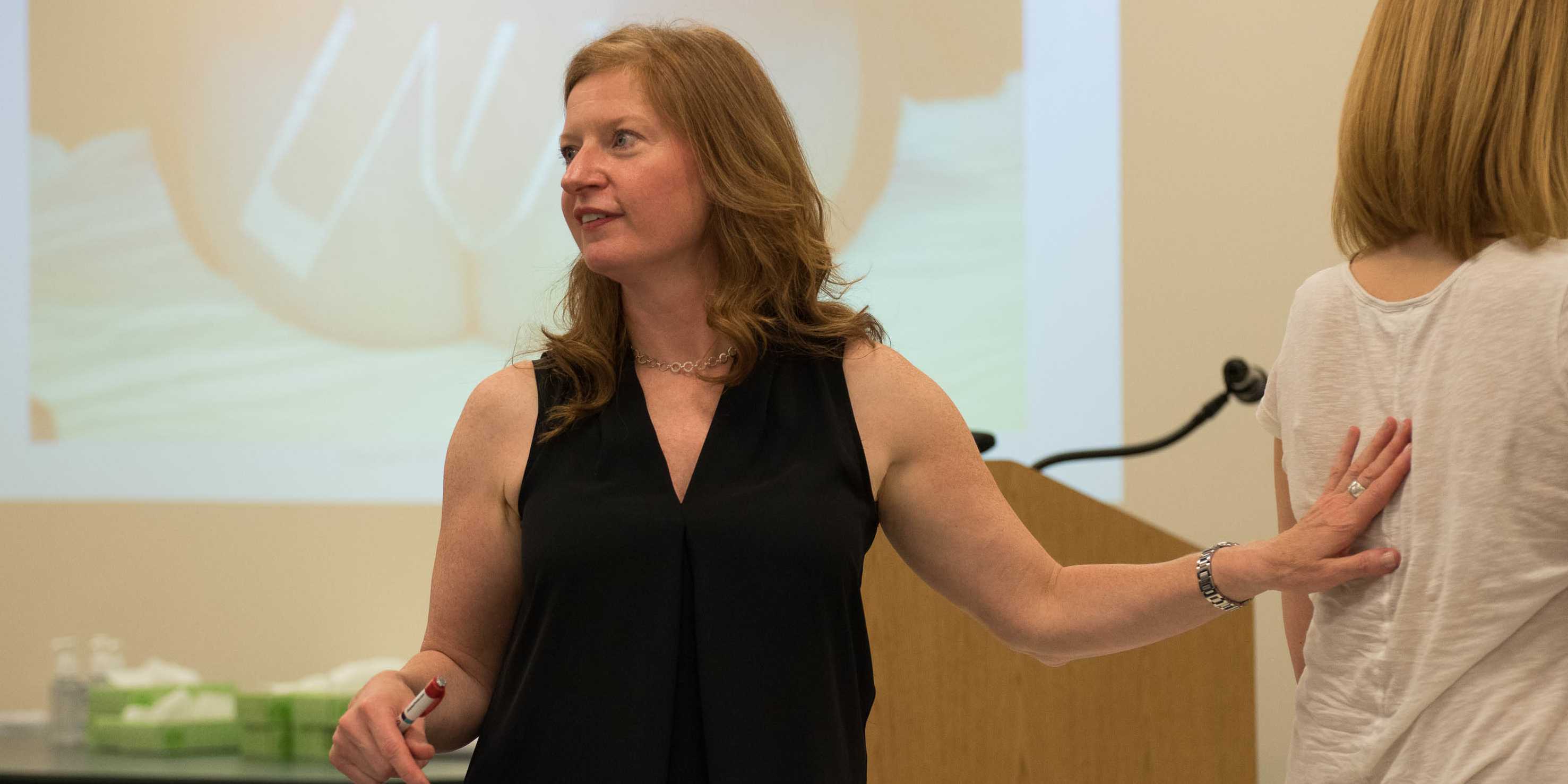Today the Pelvic Rehab Report presents a conversation with Dr. Kimberlee Sullivan, DPT. Kimberlee was kind enough to share her thoughts on the importance of pelvic rehab and her experiences in the field.

Tell us about your clinical practice.
Sullivan Physical Therapy is an outpatient private practice physical therapy clinic in Austin, Texas that specializes in women's and men's health. We have seven physical therapists who evaluate and treat pelvic floor dysfunction, pre and postpartum, pediatric bladder and bowel dysfunction, and lymphedema. Our practice takes a full body approach that looks at a person from different aspects to analyze how various factors in their life may be contributing to their symptoms. We also strive to be an integrated health care practice that communicates well with both the patient and their referring physician or multiple practitioners. The physical therapists work closely with the patient's entire medical team in order to provide the best care.
How did you get started doing pelvic rehab?
I attended physical therapy school with the idea that I would work in sports medicine. As the daughter of a college football coach, my whole life had been surrounded by athletes and this made sense with my Bachelor's in Sports Medicine. Fortunately, I had the wonderful opportunity to be able to have one of my clinical affiliations at a women's health clinic. This was very rare for the early 2000's. I thought that I would be able to work with female athletes or those women who were having back pain with pregnancy. I had no idea what I was in for nor that I would instantly fall in love with it. There is no better feeling in the world than helping someone with such private matters as incontinence, constipation and pain with intercourse. I feel lucky every day that a flip of the coin allowed me the opportunity that became my professional passion.
How do you feel the addition of pelvic rehab provides a unique service to your community?
There are so many people that suffer in silence with pelvic floor dysfunction. It is unfortunate that patients often feel embarrassed by their symptoms and that they are all alone. It is so rewarding to be able to help patients achieve their goals that relate to some of the basic aspects of life such as bladder function, bowel function, and sexual function. Patients who once felt that they would have to live with their pelvic symptoms now have a place to go that can help them reach their goals.
What skills have their therapists been trained in that they have found most helpful?
I asked the six women I work with and they felt what was most helpful was connective tissue manipulation, visceral mobilization, orthopedic approaches for treatment of the spine, pelvis and hip, understanding of how hormones can influence pelvic pain, lymphedema, pre-and post-natal care and specialized care for the male patient.
In addition, our therapists are constantly pushing themselves and each other to learn more and bring themselves to the next level. They communicate not just with local physicians to learn more about the pelvic floor, but they communicate with the top physician's in the country that treat pelvic floor disorders. An example of this is my coworkers' blogs of "Blog about Pelvic Pain" and "What is Up Down There?" We try to keep our finger on the pulse of physical therapy treatment but at the same time educate the public as we learn.
Do you find that medical providers and referral sources are still surprised at all the of conditions pelvic rehab providers can treat?
Absolutely! This will probably never end as our profession evolves. But I have to say it is much better and is getting better. I see this in the number of patients we see. Ten years ago we were fighting to have providers understand what we could offer their patients and we were seeing about 7 patients a week. Now we see around 220 patients a week and have providers calling us asking our opinion on their patients. It has been a long road, but I think as we get better as a profession communicating what we do we will see our practices continue to grow. It is exciting not only to inform providers of what we do, but also to see their faces and the faces of other physical therapists when we tell them what we do. "You do what? And it works?" Yes I do AND yes it does!
What are challenges you face managing a clinic? What are some things that have helped you get over these challenges?
I think the main challenge is the ever changing challenge of reimbursement. We chose to have a clinic that was contracted with insurances in order to provide less stress to patients who were already under so much stress dealing with their current conditions. However, insurance companies have difficulty recognizing that care can sometimes take a while for someone who has been suffering with pain for years or that a specific type of treatment could be beneficial to a patient having trouble understanding how to contract or relax their pelvic floor muscle. With all the new Medicare and other insurance paperwork requirements, I have to remind my staff why we do all of this extra work. At the end of the day the patients' care should and does always come first. As a team we participate in a lot of webinars and research to make sure that even if insurance changes, we will be here for the patients and provide them with the best care.
What aspect of your program do you look forward to further developing?
As we continue to grow and develop new programs we have discovered that there are a lot of physical therapists who are not as lucky as we are to have seven physical therapists to work with. We have a physical therapist office that is always full of discussion, sharing ideas and challenging current thought. We have had several physical therapists and physical therapist assistants come to visit us in Austin and asking to stay connected to that type of environment. For this reason, we have established a mentorship program for licensed physical therapists who are not in Austin but would like to have access to an enriching environment to efficiently grow in Women's and Men's Health Physical Therapy. In addition, we are looking at different possibilities for conducting research at the clinic in order for us to contribute back to our profession.
How has H&W helped you reach your goals?
Herman & Wallace has provided me with extraordinary information and skills in order to better serve my patients and also challenge my staff. Herman and Wallace provides classes that are up to date and constantly evolving. The instructors provided by Herman and Wallace are highly skilled therapists who are able to answer questions and challenge you to be a better physical therapist. We especially find value in the excellent lab experiences provided by Herman & Wallace.
If you could get a message out to other providers about pelvic rehab, what would it be?
Pelvic floor physical therapy is very different from orthopedic physical therapy in that both internal and external work is performed and that treatment goes so much further than instructing patients to perform kegels. It is usually of sensitive nature and patients need to feel comfortable knowing there are providers qualified to address their concerns. Every patient is different and so is treatment. I would also encourage providers to ask all of their patients if they have any bladder, bowel, or pelvic pain issues and if the answer is yes to assist them in finding the help they need.
If you are in a solo practice, find a way to stay connected with other practitioners. There is so much information coming out that it is impossible to stay up to date without accessing resources or other practitioners. I feel very fortunate to work in a practice that is set up for the physical therapists to constantly ask questions and bounce ideas off the each other.
If you could get a message out to patients/ the community at large about pelvic rehab, what would it be?
Recognize that the pelvis is just another part of your human body, just like your low back. Do not be fearful about discussing this region of your body. You would be surprised at how many other people are dealing with the same issue. Pelvic floor physical therapy can be a very effective conservative treatment for those suffering from bladder and bowel dysfunction as well as pelvic pain. Many people suffer from these diagnoses and do not know there is treatment available. Even though pelvic floor physical therapy may sound scary for those that are not familiar, an experienced physical therapist should put you at ease by walking you through step by step of what to expect and always making sure you are comfortable before proceeding. Pelvic floor rehabilitation can be powerful in changing and eliminating pelvic floor symptoms. For many patients, this is life-changing so please continue to advocate for yourself.
Today we are happy to share an interview with Blair Green, PT! Blair brings her experience as both a practitioner and a clinic owner to the field of pelvic rehabilitation, and you can check out her insights below.
Tell us about your clinical practice
I am an owner of One on One Physical Therapy, in Atlanta, GA. My patient population is primarily patients with pelvic pain of varying degrees. I blend my skills and knowledge of pelvic health with orthopedic manual therapy and I am able to provide a comprehensive approach to treating these patients. I also work closely with postpartum women for rehabilitation following childbirth, primarily in an orthopedic sense. I like to work with women who experience diastasis recti following pregnancy and who want to return to an active lifestyle after having children. One other area that interests me is the relationship between autoimmune disorders / endocrine function / pelvic pain. I hope to expand on this in the future.
How did you get started doing pelvic rehab?
I started doing pelvic rehab after taking a course linking orthopedic manual therapy with pelvic floor dysfunction. At the time I was working with many pregnant and postpartum women and hoped to gain some insight into the role of the pelvic floor in this population. I was the only orthopedic PT in the course. At that point I realized I could not treat the hip / SIJ / lumbar spine in isolation and I needed to consider the role of the pelvic floor with this population. This opened many doors for me and I soon found myself fully entrenched in the world of pelvic floor rehabilitation.
How do you feel the addition of pelvic rehab provides a unique service to your community?
In Atlanta, many PTs address orthopedics but very few address the pelvic floor. I am able to treat patients from all over the state of Georgia. In addition, I have spent a great deal of time educating my colleagues and DPT students on the role of the pelvis and pelvic floor and why it cannot be ignored in many cases of low back, hip and pelvic pain. I also consult with different organizations in Atlanta who work with pregnant and post partum women. I am able to talk to their clients and staff members about the role of physical therapy in Obstetrics.
What skills have their therapists been trained in that they have found most helpful?
What skills do I find most helpful? I think they are all helpful. Every patient is different. Some require extensive hands-on manual therapy, others need continual supervised exercise instruction. For some, education is key. I have certifications in Pilates and Trigger Point Dry Needling. Both of these were “game changers” for me. More recently I am incorporating a lot of work by Paul Hodges, Diane Lee, Julie Wiebe and Lorimer Moseley. I am becoming very integrative and holistic in my approach and I enjoy this.
Do you find that medical providers and referral sources are still surprised at all the of conditions pelvic rehab providers can treat?
I think they are surprised that physical therapists can do so much to help women with pelvic pain. Most medical providers I meet are so thrilled to have a PT to work with. A few years ago, they never would have imagined that physical therapists would be so crucial in the plan of care for these patients.
What are challenges you face managing a clinic? What are some things that have helped you get over these challenges?
One of the biggest challenges I face is how to continue to treat patients and still have time to focus on growing my business, training new PTs and educating referral sources on what we do. There is just not enough time to do it all! It’s hard to prioritize.
What aspect of your program do you look forward to further developing?
Our pelvic floor team is growing. It was just me for a long time. Now we have 3 PTs that treat pelvic health and I hope we can continue to grow this team. I love to learn from my colleagues and I love that we can all work together to get the word out about One on One Physical Therapy and what we do.
How has H&W helped you reach your goals?
I am always impressed by the courses presented by H&W. I started in PF 2A and have worked my way through many classes. I love the instructors and have used them as mentors at times, always looking for their clinical pearls. In addition, one of my PTs I recently hired I met at a H&W course. We were lab partners. We stayed in touch for 5 years until the timing was right for her to come on board!
If you could get a message out to patients/ the community at large about pelvic rehab, what would it be?
I would want to get the message out there that incontinence, pain with intercourse, constipation, abdominal pain, post-pregnancy pain - none of these conditions are normal. Pelvic health PTs can help treat these problems and teach you many tools so that you do not have to live with these symptoms. I love to joke with friends and patients that I am a “vagina physical therapist.” It’s humorous but people definitely inquire more. I am able to get my message out there!










































